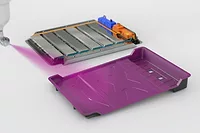Jotun Targets Battery Safety

Image courtesy of Jotun.
Jotun has introduced a suite of powder coating technologies designed to address challenges in battery safety, performance and production efficiency for electric vehicles (EVs) and energy storage systems (ESS).
As global investment in electrification accelerates, demand for lithium-ion batteries is rising. According to the IEA Global EV Outlook 2023, annual EV sales are projected to exceed 40 million units by 2030, with battery manufacturing capacity reaching 4,548 GWh. In parallel, increased renewable energy adoption is driving demand for grid-scale battery systems.
Jotun developed its latest powder coating solutions in collaboration with leading battery manufacturers in China. These coatings support key functions including electrical insulation, thermal management, fire resistance and corrosion protection. The goal is to extend battery life, enhance safety and reduce manufacturing complexity.
Launched in 2025, the product portfolio includes coatings for multiple battery components. The systems are designed to prevent thermal runaway—a condition that can result in fire or explosion when batteries overheat. They also offer resistance to corrosion caused by moisture, salt and chemicals, contributing to long-term battery performance and safety.
“Powder coatings offer an efficient, solvent-free alternative to traditional protective systems, which are often resource-intensive and unstable,” said Mehmet Ali Kamacıoğlu, global sales and marketing director for powder coatings at Jotun.
The solutions also support manufacturing sustainability by helping companies reduce volatile organic compound (VOC) emissions and streamline application processes. Jotun’s global technical support teams work with OEMs to ensure coating selection and application are optimized from the start.
The same technologies can be applied to ESS infrastructure. Coatings rated for highly aggressive environments—classified as C5VH or CX per ISO 12944—are available for use on containerized energy storage units in the field.
“Battery technology is evolving rapidly,” said Kamacıoğlu. “By working closely with manufacturers, we’re able to adapt to new requirements and contribute to safer, longer-lasting battery systems in both mobility and energy applications.”
Looking for a reprint of this article?
From high-res PDFs to custom plaques, order your copy today!








